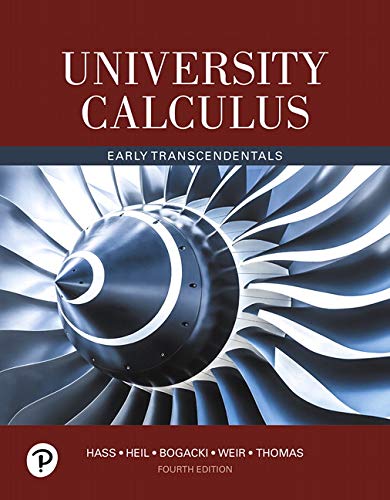
In Exercises 5−8, r(t) is the position of a particle in the xy-plane at time t. Find an equation in x and y whose graph is the path of the particle. Then find the particle’s velocity and acceleration
7.
Learn your wayIncludes step-by-step video

Chapter 12 Solutions
University Calculus: Early Transcendentals (4th Edition)
Additional Math Textbook Solutions
Calculus: Early Transcendentals (2nd Edition)
Algebra and Trigonometry (6th Edition)
College Algebra (7th Edition)
Elementary Statistics: Picturing the World (7th Edition)
Basic Business Statistics, Student Value Edition
- xp x+xarrow_forwardFor the given graph, determine the following. -3 12 УА 4 3 - -1 ° 1 2 3 x -1. -2- a. Determine for which values of a the lim f (x) exists but f is not continuous at x = a. a b. Determine for which values of a the function is continuous but not differentiable at x = a. aarrow_forwardUse the following graph of ƒ (x) to evaluate ƒ' (−1) and ƒ' (2). y +10+ 9 8 7 6 5 4 3 2 1- -10 -9 -8 -7 -6 -5 -4 -3 -2 -1 x 3 4 0 8 9 10 -2 3 -4 5 -6 -7 -8 -9 -10- f'(-1)= f' (2)arrow_forward
- For the following function f and real number a, a. find the slope of the tangent line mtan = = f' (a), and b. find the equation of the tangent line to f at x = a. f(x) = 2 = ;a=2 a. Slope: b. Equation of tangent line: yarrow_forwardFor the following function f and real number a, a. find the slope of the tangent line mtan = f' (a), and b. find the equation of the tangent line to f at x = a. f(x) = 2x² + 3x; a = 2 a. Slope: b. Equation of tangent line: yarrow_forwardFor the following function f and real number a, find f' (a). f(x) = = √x+4; a = 0 f' (a)arrow_forward
- Find the slope of the secant line between the values x₁ and x2 for the function y = f (x). Answer exactly or round to 2 decimal places. f(x) = √√x x7; x₁ = 11, x2 = 23 Slope:arrow_forwardFor the following function f and real number a, find f' (a). f(x)=8x+6; a = −3 f' (a)arrow_forwardFind the slope of the secant line between the values 1 and 2 for the function y = f(x). Answer exactly or round to 2 decimal places. 2 f(x)= ; = x12, x24 2, x2 = 4 2x 1 Slope: Submit Questionarrow_forward
- answer a, b, and carrow_forwardA population of muffles (a feathery species unrelated to tribbles) begins with 30 animals and has 100 animals after 36 hours.arrow_forwardA population of muffles (a feathery species unrelated to tribbles) begins with 30 animals and has 100 animals after 36 hours. 1. Find a formula describing the growth of the muffle population (4 points). Round any decimals to five decimal places.arrow_forward
- Algebra & Trigonometry with Analytic GeometryAlgebraISBN:9781133382119Author:SwokowskiPublisher:Cengage
 Algebra: Structure And Method, Book 1AlgebraISBN:9780395977224Author:Richard G. Brown, Mary P. Dolciani, Robert H. Sorgenfrey, William L. ColePublisher:McDougal Littell
Algebra: Structure And Method, Book 1AlgebraISBN:9780395977224Author:Richard G. Brown, Mary P. Dolciani, Robert H. Sorgenfrey, William L. ColePublisher:McDougal Littell

